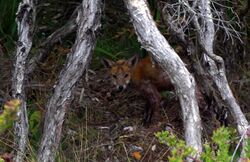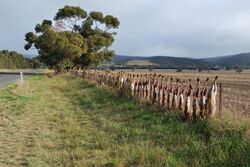Red foxes in Australia
Topic: Biology
 From HandWiki - Reading time: 7 min
From HandWiki - Reading time: 7 min
Red foxes pose a serious conservation problem in Australia . 2012 estimates indicate that there are more than 7.2 million red foxes (Vulpes vulpes)[1] (and growing), with a range extending throughout most of the continental mainland.[2] The species became established in Australia through successive introductions, by settlers, beginning around the 1830s. Due to its rapid spread and ecological impact, it has been classified as one of the most damaging invasive species in Australia.
Introduction and spread
European red foxes were introduced to the British colonies of Van Diemen's Land as early as 1833, and to the Port Phillip District and Sydney Regions of New South Wales as early as 1845; introductions were, originally, intended to uphold the traditional English sport of fox hunting. Curiously, prior to 2010, a permanent fox population was not established on the island of Tasmania, and it is widely held that they were outcompeted by the Tasmanian devil (Dasyuridae).[3] Since 2010, however, red foxes have been accounted-for on Tasmania. On the mainland, the species was successful as an apex predator, with the absence of numerous large, mammalian carnivores (excepting dingoes, which occasionally hunt the foxes). The spread of the red fox across the southern regions of Victoria, South and Western Australia coincided with the spread of rabbits on the continent, another invasive species introduced in the 19th century with the intention of being hunted for sport.
Current distribution
Established populations of red fox are found in all states, and are widespread throughout the country (with the exception of tropical areas of northern Queensland, the Kimberley and the Top End of the Northern Territory). Since 2010, confirmed evidence of foxes in Tasmania has been reported by the state's Department of Primary Industries, Parks, Water and Environment.[4] Foxes are also found in ever-higher concentrations in densely-populated suburban areas, as well as in large cities such as Melbourne.[5]
It is (generally) less common in areas where the dingo is more prevalent; however, it has, primarily through its burrowing behaviour, achieved niche differentiation with both the feral dog and the feral cat.
Ecological impacts
The West Australian conservation department, CALM, estimates introduced predators are responsible for the extinction of ten native species in that state. Red foxes have been directly implicated in the extinction and decline of populations of the family Potoroidae, including the extinction of the desert rat-kangaroo.[6]
The spread of the red fox population corresponds directly with the declining populations of several endemic terrestrial marsupials, including the brush-tailed, burrowing and rufous bettong, the bilby, numbat, bridled nailtail wallaby and the quokka.[7] Most of these species now only live in limited areas (such as islands) where red foxes are absent or rare. In 2016, researchers documented that some red foxes in Australia had learned to climb trees to look for baby koalas (and other unsuspecting creatures, such as sugar gliders), dispelling the long-held belief that arboreal creatures were safe from them.[8]
Alternatively, some researchers argue that there could be benefits with the presence of red foxes, primarily in suppressing the number of rodents, rabbits, and even feral cats in Australia, and eradication of foxes may harm native ecosystems inadvertently.[9][10]
Management and control
Local eradication programs exist, although eradication has proven difficult due to the denning behaviour and nocturnal hunting, so the focus is on management with the introduction of state bounties.[11] Within smaller fenced reserves, eradicating feral cats and foxes can allow the reintroduction of extirpated mammal species.[12] However, eradication can be very time-consuming and labour-intensive. At the Australian Wildlife Conservancy's Pilliga reserve, a red fox nicknamed Rambo evaded all attempts to trap, poison, or shoot him for four and a half years, delaying planned mammal reintroductions until the fox's presumed death in 2022.[12]
The main form of control is baits, typically containing 1080 poison. Fox hunting is legal in all states and they are typically shot with the aid of spotlighting at night or attracted using fox whistles during the day. The eyeshine signature (from the tapetum lucidum in the eye) of foxes, and body shape and silhouette are used to identify them.
The reintroduction of competitive species has also been suggested as a method of control. Research by the CSIRO concluded that the presence of dingos not only decreases the presence of foxes but increases native fauna.[13] Chris Johnson of James Cook University and Euan Ritchie of Deakin University have advocated the reintroduction of Tasmanian devils to the mainland to perform a similar role, as evidenced by the past eradication of foxes from Tasmania, as well as to ensure the ongoing survival of that native species.[14][15][16][17]
Western Shield Program
Western Australian state government authorities conduct aerial and hand baiting on almost 35,000 square kilometres (14,000 sq mi) to control foxes (and feral cats) as part of the Western Shield pest management program.
Fox Free Tasmania program
According to the Tasmanian government, red foxes were introduced to the previously fox-free island of Tasmania in 1999 or 2000, posing a significant threat to native wildlife, including the eastern bettong, and an eradication program conducted by the Tasmanian Department of Primary Industries and Water was established.[18][19] An independent member of the Tasmanian state Parliament, Ivan Dean, has claimed that the fox introductions are a hoax, a claim the Minister for Primary Industry, David Llewellyn described as a "load of rubbish".[20]
Targeted baiting was conducted by the fox task force throughout the 2000s, ending in 2013 at a cost of over $50 million dollars,[21] after no evidence of foxes had been detected since 2011.[22] In 2015, a study indicated that if foxes had ever been in Tasmania, they were extinct by that time.[23]
In 2016, an internal Department of Primary Industries report was leaked to the ABC that indicated zoologists employed by the Tasmanian Fox Taskforce had questioned if the data the program was based on was in fact fake. In addition, four fox carcasses found in Tasmania were determined to have been hoaxes imported from Victoria and that study of the 60 possible fox faeces collected, 26 were determined to have been faked, possibly by an employee of the task force, and 11 were not from foxes at all. Independent MP Ivan Dean filed a police complaint of fraud in light of the report's data.[24] No charges were laid but the Tasmanian Integrity Commission subsequently investigated the claims, concluding that there was not sufficient evidence that hoaxes had been perpetrated by the task force on a large scale but that samples had been mishandled, some evidence had been embellished, that a taskforce officer had probably organised with another person to fake a report so that the taskforce could gain access to private property, and that the program had failed to issue corrections when evidence was later found to be a hoax.[25]
Tasmania is estimated to have the carrying capacity to support a population of up to 300,000 foxes.[26]
See also
References
- ↑ "Impacts of Feral Animals". Game Council of New South Wales. http://www.gamecouncil.nsw.gov.au/portal.asp?p=Ferals1.
- ↑ Macdonald, David (1987) (in en). Running with the Fox. Unwin Hyman, London. p. 14.
- ↑ Bostanci, A. (2005). "A Devil of a Disease". Science 307 (5712): 1035. doi:10.1126/science.307.5712.1035. PMID 15718445.
- ↑ "Latest Physical Evidence of Foxes in Tasmania". http://www.dpiw.tas.gov.au/inter-nsf/WebPages/LJEM-6SH7FX?open.
- ↑ Green, Michael (3 July 2014). "Little fox, big problem". https://www.theage.com.au/national/victoria/little-fox-big-problem-20140703-3bboh.html.
- ↑ Short, Jeff (13 September 1999). "The extinction of rat-kangaroos (Marsupialia:Potoroidae) in New South Wales, Australia". Biological Conservation 86 (3): 365–377. doi:10.1016/S0006-3207(98)00026-3.
- ↑ "Threat Abatement Plan for Predation by the Red Fox (Vulpes vulpes)". SW National Parks and Wildlife Service. 2001. http://www.environment.nsw.gov.au/resources/pestsweeds/RedfoxApproved.pdf.
- ↑ Alice Klein (10 February 2017). "Foxes seen climbing trees at night to track down and eat koalas". New Scientist. https://www.newscientist.com/article/2120944-foxes-seen-climbing-trees-at-night-to-track-down-and-eat-koalas/.
- ↑ Arian D. Wallach, 2014, Red Fox, Dingo for Biodiversity Project
- ↑ Emily Hanna, Marcel Cardillo, Shai Meiri, 2013, Island mammal extinctions are determined by interactive effects of life history, island biogeography and mesopredator suppression, Global Ecology and Biogeography, DOI:10.1111/geb.12103, Wiley Online Library
- ↑ Millen, Tracey (October–November 2006). "Call for more dingoes to restore native species". ECOS 133. http://www.publish.csiro.au/?act=view_file&file_id=EC133p5a.pdf. (Refers to the book Australia's Mammal Extinctions: a 50,000 year history. Christopher N. Johnson. ISBN:978-0-521-68660-0.
- ↑ 12.0 12.1 Fontaine, Angus (14 March 2023). "‘It’s over’: five-year hunt for Rambo the feral fox paves way for greater bilby to roam free" (in en-AU). The Guardian Australia. https://www.theguardian.com/environment/2023/mar/13/its-over-five-year-hunt-for-rambo-the-feral-fox-paves-way-for-greater-bilby-to-flourish-again.
- ↑ Tracey Millen (October–November 2006). "Call for more dingoes to restore native species". ECOS 133. http://www.publish.csiro.au/?act=view_file&file_id=EC133p5a.pdf. (Refers to the book Australia's Mammal Extinctions: a 50,000 year history. Christopher N. Johnson. ISBN:978-0-521-68660-0.
- ↑ "PM - Calls for Tasmanian Devil to return to the mainland". Abc.net.au. http://www.abc.net.au/pm/content/2006/s1780061.htm.
- ↑ "Opinion Introduced species to complicate problem". Weekly Times Now. 10 May 2012. http://www.weeklytimesnow.com.au/article/2012/05/10/479991_opinion-news.html.
- ↑ "The Geelong Advertiser". The Geelong Advertiser. 26 March 2012. http://www.geelongadvertiser.com.au/article/2012/03/26/315981_news_pf.html.
- ↑ Dingoes, devils may be angels in disguise › News in Science (ABC Science). Abc.net.au. 27 March 2012. doi:10.1016/j.tree.2012.01.001. PMID 22321653. http://www.abc.net.au/science/articles/2012/03/27/3464743.htm. Retrieved 18 August 2013.
- ↑ "Hard Evidence of Foxes Discovered in Tasmania". Department of Primary Industries and Water, Tasmania website. http://www.dpiw.tas.gov.au/inter.nsf/WebPages/LJEM-6SH7FX?open.
- ↑ "Foxes in Tasmania : A Report on an Incursion by an Invasive Species". Dpiw.tas.gov.au. http://www.dpiw.tas.gov.au/inter.nsf/Attachments/LBUN-6R26BF/$FILE/Fox%20Review%20Report%20June%2022%202006.pdf.
- ↑ "Tassie 'hoodwinked". Mercury newspaper website. http://www.news.com.au/mercury/story/0,22884,21582109-921,000.html.[|permanent dead link|dead link}}]
- ↑ "Fox in Tasmania - Eradication Program Dropped" (in en-AU). Invasive Species Council. 29 June 2013. https://invasives.org.au/blog/fox-in-tasmania-eradication-program-dropped/.
- ↑ "Foxes in Tasmania - Update | The Australian Mammal Society Inc.". Australian Mammal Society. https://australianmammals.org.au/articles/2014/10/18/foxes_in_tasmania__update.
- ↑ Johnson, Christopher; Jones, Menna Elizabeth (24 March 2015). "Tasmania's fox hunt was worth it, even if there were no foxes" (in en). The Conversation. https://theconversation.com/tasmanias-fox-hunt-was-worth-it-even-if-there-were-no-foxes-34045.
- ↑ Blucher, Alexander; Schwartz, Dominique (28 November 2016). "Multi-million-dollar fox hunt 'likely based on hoax'" (in en-AU). ABC News (Australian Broadcasting Corporation). https://www.abc.net.au/news/2016-11-29/tasmanias-multi-million-dollar-fox-hunt-based-on-likely-hoax/8049560.
- ↑ "Report 4 of 2017 summary". Tasmanian Integrity Commission. https://www.integrity.tas.gov.au/publications/publications/investigation-reports/2017/report-4-of-2017-summary.
- ↑ "DRAFT: Recovery Plan for the Tasmanian devil (Sarcophilus harrisii)". Department of Primary Industries, Parks, Water and Environment. http://www.environment.gov.au/biodiversity/threatened/publications/recovery/pubs/draft-for-comment-tasmanian-devil.pdf.
 |
 KSF
KSF


